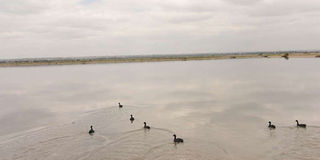Sanitation for all is possible by 2030

Ruai Sewage Treatment Plant in Nairobi on August 15, 2019. Proper wastewater disposal is necessary. PHOTO | FILE | NATION MEDIA GROUP
What you need to know:
- To avoid polluting our groundwater and stop the flow of toxic waste water into our rivers, stricter control of wastewater discharge is necessary.
- Communities should instal such plants instead of constructing individual septic tanks in every small development.
For every 10 litres of water that we use, 8-9 litres end up as waste — a reality engineers grapple with in designing wastewater treatment systems.
And while this is easy to handle in a family setting, it becomes a completely different undertaking with a community of, say, 5,000 or even 50,000 people.
With the population of the Nairobi metropolis at 6.5 million, the wastewater amounts the residents produce is huge.
With each person using 150 litres of water per day, that translates to 975,000,000 litres of water which we convert into wastewater daily. With this quantity, it would take 84 days to fill Ndakaini Dam.
The wastewater we have calculated above is for domestic use alone, leaving out industries, hospitals, hotels and such other institutions. Actually, the rate of wastewater generation from these latter facilities is much higher.
WASTE DISPOSAL
The implication of this is that we have to find a way of dealing with the disposal of such a huge amount of wastewater.
Among them is the use of septic tanks or connection to a public sewerage draining into the municipal treatment plant.
Other people simply drain it into open fields while others use soak pits and various other forms of soakage.
There is a small but growing percentage of people using more mechanised treatment systems — such as membrane bioreactors (MBR) and moving membrane bioreactors (MBBR) technologies.
In an impact report on Kenya’s water services sector in 2017/18 released by Water Services Regulatory Board (Wasreb), the sewered sanitation coverage is a paltry 16 per cent.
The rest either use non-sewered sanitation systems or don’t have proper sanitation at all.
SAFETY MEASURES
A popular mode of sanitation among the urban middle class is the use of a septic tank with the overflow being taken to a soak pit or trench.
The soakage drains the overflow from the tank into the ground. The tank drains grey and black water and is regularly exhausted after some time to remove the volume of solids and empty it for continual use.
The soakage draining the overflow into the ground is assumed to be safe. However, the soakage should be limited to a depth of 3-6 metres deep.
Well-drained soils are better suited for this than clay soils, which are poor in draining.
One problem of soakage in a densely populated area is that the soil is permanently wet, hence a high risk of polluting groundwater.
It is possible to drill your borehole only to find that the water is actually raw sewage. Conventionally, a population of more than 300 should not use septic tank sanitation.
But due to lack of regulations, or their enforcement, septic tanks and soak pits are common.
POLLUTION
With the amounts of wastewater earlier mentioned in this article, imagine that the bigger percentage of that ends up in the ground untreated or in our rivers.
In August, a feature on NTV and in the Daily Nation, "Toxic Flow", that traced Nairobi River from the source to the end demonstrated how the river picked up pollution as it passed through urban areas.
The need for a proper system of sanitation becomes very obvious. To avoid polluting our groundwater and stop the flow of toxic waste water into our rivers, making it harmful to use downstream, stricter control of wastewater discharge is necessary.
It will be important to limit the use of soakage, especially in urban areas or others with a high population density, and ensure an end-to-end treatment of all waste water generated for domestic, commercial, industrial use.
This will involve on-site wastewater treatment, which makes the water reusable for gardening, outdoor cleaning and other small-scale non-potable use.
AWARENESS
There are products in the market which recycle wastewater to safe levels for reuse.
Communities should instal such plants instead of constructing individual septic tanks in every small development.
They should be sensitised on the pollution risk of underground water that is exposed to soakage.
A policy to regulate on-site wastewater treatment to complement the sewered sanitation would help the government to achieve sanitation for all by 2030.
During the sanitation conference organised by the Ministry of Water, Sanitation and Irrigation at KICC from Monday to Thursday, the stakeholders should take stock of the situation and a quick sense of awareness emerges with an actionable way forward developed to drive a sustainable way to make sanitation for all a reality.
The aspiration is captured in the UN Sustainable Development Goal (SDG) 6 and the legal framework set out in Articles 43(1)(d) and 21(2) of the Constitution and the Water Act 2016.
The final spoke in the wheel of the sanitation for all vision is the enactment and enforcement of the relevant policies.
Mr Kiteme is a civil structural engineer. [email protected]





